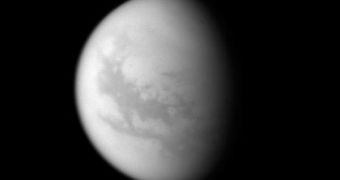According to a research presented December 4 at the 2010 annual fall meeting of the American Geophysical Union (AGU), it would appear that the Saturnine moon Titan may have he capability to sustain the formation of biomolecules on its surface.
These molecules would resemble the amino-acids, the basic building blocks of life here on Earth, a team of scientists argued at the conference. It is not that far-fetched to believe that basic lifeforms could develop on the space object, they implied.
Past investigations have revealed without a doubt that Titan's atmosphere contains organic molecules. The new work builds up on that, showing potential development mechanisms, through which molecules falling to the ground could form life's building blocks.
The team believes that these precursor chemicals may interact with liquid water brought on Titan by comets, or by cryovolcano eruptions. Also at the meeting, another group presented evidence to support the discovery of the first ice volcano on the moon.
It is believed that the reaction between the organic molecules and liquid water could lead directly to the synthesis of biomolecules such as amino acids, Space reports.
But the main issue with this is that the average temperature on Titan drops to nearly minus 180 degrees Celsius, which means that frozen water here is harder than granite. Still, the research team that presented the findings says that water can remain liquid long enough to initiate the reaction.
“It's very possible that you could get biomolecules,” explains Johns Hopkins University (JHU) Applied Physics Laboratory (APL) expert and study author Catherine Neish.
She explains that, due to the vast concentrations of nitrogen in Titan's atmosphere, it's highly unlikely biomolecules can form in the air. The expert explains that insufficient amounts of oxygen are available for this reaction.
The the atmospheric chemicals “continually trickle down out of the air,” Neish explains. If they meet liquid water, the may kick-start chemical reactions that would lead to the development of biomolecules.
Though temperatures are very low, past investigations have revealed that liquid water formed following cometary impacts can endure on the surface of the Moon for 100 to 1,000 years.
In a series of experiments, Neish demonstrated that this time frame is more than enough for biomolecules to develop.
After mimicking the conditions on Titan, she was able to obtain four identifiable amino acids – asparagine, aspartic acid, glutamine and glutamic acid – within just a few days of starting the reaction.
But the new discoveries have not convinces Neish that life exists on the moon. “I'm fairly pessimistic about the prospects of life on Titan,” she explains.
“To sustain life, you need some sort of energy source. And there's just not a lot of energy there,” the expert adds.

 14 DAY TRIAL //
14 DAY TRIAL //